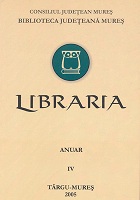Restaurarea unui calendar popular maghiar din 1781
The Restoration of a Hungarian Calendar from 1781
Author(s): Krisztina MártonSubject(s): Museology & Heritage Studies, Library and Information Science, Preservation, 18th Century
Published by: Biblioteca Județeană Mureș
Keywords: Hungarian Calendar; 1781; Restoration;
Summary/Abstract: This calendar belongs to the Teleki-Bolyai Library from Târgu-Mureş, which opened its gates to the public in 1802, founded by Count Sámuel Teleki, chancellor of Transylvania. This library owns over 200,000 volumes, of which 40,000 were the basic collection gathered by Teleki from 25 different European countries. A later addition to this was the collection of 80,000 volumes belonging to the former Reformed College, named Bolyai Farkas after the great mathematician, who was citizen of this town. Later additions were the remains of libraries from monasteries, castles left without communities. This print is a calendar on the year 1782, so we can sustain almost surely, that it was edited in 1781 and started its way on a market organized usually on the last day of the year, among other objects believed to be fortune bringers on the year to come. The booklet is composed of five units, each with different numbers of leaves. Between the printed sheets there are included leaves of blank paper, meant to receive the notes of the future owner. These last ones seem to be of a different kind of paper. On a single one of these, there is to find the fragment of a watermark, which indicates an animal shape. It was bound in boards, as the fragments kept and the analogies indicate. The print is bicolor: black and red. The red ink was used to highlight the titles, the symbols and the holidays. The calendar is structured on several chapters: on the first page kept we can read the key to the signs and abbreviations used along the texts. The first chapter is the calendar itself, than followed by the prognosis on the weather and health for the year to begin. An important chapter was the one containing the list of markets with the dates and places where there were to be held. The last chapter was a chronicle of the Hungarians, from the beginnings to contemporary events. The state of conservation: the object showed different types of degradation. As effect of inadequate handling, the bounds were missing, many sheets were torn or kept in fragments. A continuous layer of dirt, accidental drops of different substances and water stains covered the whole surface. As chemical damage there should be mentioned that the adhesive has weakened during time, due to a high level of humidity in the air. This way the paper became more hydrophilic. A grown level of acidity could be noticed as a general yellowish colour of the paper. Due to both chemical and biological factors, in some parts more sheets formed unseparable blocks of paper. The biological damage was produced both by fungus and insects. The insect left behind lacks of material, galleries and fly-holes. The fungus destroyed the inner structure of the paper and stained the paper in different colours, which proved the presence of different species. There were made several types of analysis to identify the biological agents, to measure the pH-level, to identify the type and contain of the clueing agent and the type of paper used, so that the completing could be done with the matching type of Japanese paper. The first step of conservation was the disinfecting, followed by a photographic documentation of the initial state. (All steps and procedures were documented). After the proper airing a dry cleaning was done: dusting with a smooth brush and cleaning the more resistant dirt using erasers and scalpels. All pages have been numbered with a light pencil, then the volume was dissembled on sheets and a more profound dusting was done. After testing the solubility of the inks in water and hydro-alcoholic solutions, the sheets were immersed in baths of water and alcohol (1:2 p). The alcohol was necessary as to protect the weakened paper. After this wash the sheets were treated with CMC (carboximetil-cellulose), washing off the surplus, so that it would complete / replace the weakened original gluing. The leaves were dried free and then put in the press. After this followed the restoration: the lacks were completed with Japanese paper from both sides, avoiding overlapping the margins of the original. The thickness and the fiber-direction of the Japanese paper had to be well chosen to match the original. The used gluing agent was the same CMC. After drying, a final pressing was done and the results were checked at backlight. Before replacing the covers, we consulted more analogies and the final option fell on board bounding, covered with a layer of decorative Japanese paper. In case of finding a better solution, these covers will be easy to replace, without harming the original. Concerning the conditions of depositing the object: we propose a box with the exact size of the booklet, made of non-acid cartoon. The R. H. level should be between 50-60% and the temperature about 16-18C°. The great variation of these values can cause the most damage.
Journal: Libraria. Studii și cercetări de bibliologie
- Issue Year: IV/2005
- Issue No: 4
- Page Range: 214-226
- Page Count: 13
- Language: Romanian

